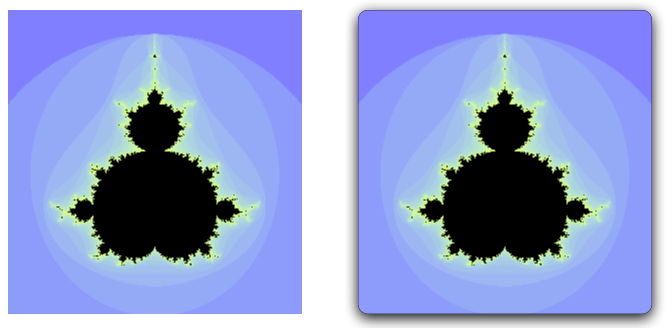Fun with layers
Fun with layers
这篇文章的有些内容很奇怪,我根本就没有这种现象,所以暂时就这样吧
In this post, I’ll explain how to add a border, rounded corners, and drop shadow to any UIView using some simple CALayer properties. I’m not a CALayer guru, but these few tricks from the layer world are particularly nice to know about.
These properties are present for every UIView, since every view is actually drawn using an underlying CALayer object owned by the UIView. You can do a lot without even knowing about CALayers because UIViews encapsulate a lot of their functionality. These properties, however, are useful pieces that are not available directly through the UIView interface.
To use these properties, you need to include the QuartzCore header:
Borders
To get a border, just set the borderColor and borderWidth properties of the layer, for example:
label.layer.borderWidth = 1;
The borderColor is a CGColorRef, which you can easily extract from any UIColor as in the above example, which generates a border like this:

The border is just inside the frame of the view. Fractional values are allowed for the borderWidth as well.
Corners
You can create rounded corners with code like this:
label.layer.borderColor = [UIColor grayColor].CGColor;
label.layer.borderWidth = 3;
just the cornerRadius property is needed; I’ve also set the border to show how these properties work together:

As you can see in the example screenshot, the backgroundColor of the UIView is also restricted by the corner radius. You need to have clipsToBounds set to YES on your UIView for rounded corners to work.
Shadows
You can also create a drop shadow that will be based on the alpha
component of whatever is drawn in your view. Often this will result in a
shadow just around the edges of the view. This example code on a UILabel:
label.layer.shadowOpacity = 1.0;
label.layer.shadowRadius = 5.0;
label.layer.shadowOffset = CGSizeMake(0, 3);
label.clipsToBounds = NO;
results in this appearance:

In this case, you need clipsToBounds to be NO
in order for a shadow outside the frame of your view to show up. Next
I’ll show you how you can actually combine rounded corners and drop
shadows, since I’m sure that’s what you really want to do now.
All together
Let’s say you want to present an image with a border, rounded
corners, and a drop shadow. The obvious problem from the above
explanations is that clipsToBounds needs to be YES for the rounded corners to work and NO for the drop shadows. What’s a coder to do?
We can get around this apparent paradox by using the fact that the CALayer treats its own background color (which may be image-based) differently than the UIView‘s background color. Specifically, we can set clipsToBounds to NO and still achieve rounded corners by using direct properties of the layer instead of the UIView. This code:
imgView.backgroundColor = [UIColor clearColor];
UIImage *image = [UIImage imageNamed:@"mandel.png"];
imgView.layer.backgroundColor = [UIColor colorWithPatternImage:image].CGColor;
// Rounded corners.
imgView.layer.cornerRadius = 10;
// A thin border.
imgView.layer.borderColor = [UIColor blackColor].CGColor;
imgView.layer.borderWidth = 0.3;
// Drop shadow.
imgView.layer.shadowColor = [UIColor blackColor].CGColor;
imgView.layer.shadowOpacity = 1.0;
imgView.layer.shadowRadius = 7.0;
imgView.layer.shadowOffset = CGSizeMake(0, 4);
Generates the image on the right, using the left image as the source (mandel.png):

Reference
I originally learned about this stuff from this blog post.
Post a comment or leave a trackback: Trackback URL.
Fun with layers的更多相关文章
- OpenLayers 3 中Layers的相关知识
昨天自己一遍又一遍的把API里Accessible map那个例子写下来,终于好像有熟悉一点点.找到一篇博文详细讲Layers的.整理一下贴出来(本来想在网上做笔记可以重新排版,比写在本子上要容易有结 ...
- Caffe学习系列(3):视觉层(Vision Layers)及参数
所有的层都具有的参数,如name, type, bottom, top和transform_param请参看我的前一篇文章:Caffe学习系列(2):数据层及参数 本文只讲解视觉层(Vision La ...
- Making raycast ignore multiple layers
I know how to make the raycast ignore a layer but I want it to ignore layers 9 and 10 but collide wi ...
- 【转】Unity3D中Layers和LayerMask解析
http://blog.csdn.net/yupu56/article/details/50441151 Unity中是用int32来表示32个Layer层.int32表示二进制一共有32位(0-31 ...
- 【Unity3D游戏开发】基础知识之Tags和Layers (三二)[转]
Tags和Layers分别表示是Unity引擎里面的标签和层,他们都是用来对GameObject进行标识的属性,Tags常用于单个GameObject,Layers常用于一组的GameObject.添 ...
- [Unity2D]Tags和Layers
Tags和Layers分别表示是Unity引擎里面的标签和层,他们都是用来对GameObject进行标识的属性,Tags常用于单个GameObject,Layers常用于一组的GameObject.添 ...
- Deep Learning: Assuming a deep neural network is properly regulated, can adding more layers actually make the performance degrade?
Deep Learning: Assuming a deep neural network is properly regulated, can adding more layers actually ...
- [原]Unity3D深入浅出 - 认识开发环境中的Layers面板
Layers(分层)下拉列表:用来控制Scene视图中游戏对象的显示,在下拉菜单中为勾选状态的物体将显示在Scene视图中. Everything:显示所有的游戏对象 Nothing:不显示任何游戏对 ...
- Investigation of Different Nets and Layers
Investigation of Different Nets and Layers Overview of AlexNet (MIT Places | Flickr Finetuned | Oxfo ...
随机推荐
- php继承与重载
<?php class A { public $param = "paramA"; public function test() { echo "testA&quo ...
- C#一个简单下载程序实例(可用于更新)
运行时的界面 using System; using System.Collections.Generic; using System.ComponentModel; using System.Dat ...
- 李洪强iOS开发之自定义cell的使用
第一步: 创建自定义cell类,继承自UItableVIewcell 第二步: 在sb中布局自己需要的视图控件并且将此cell与我刚刚创建的cell类进行关联.并且连线 第三步: 创建modle类, ...
- 常用的富文本框插件FreeTextBox、CuteEditor、CKEditor、FCKEditor、TinyMCE、KindEditor ;和CKEditor实例
http://www.cnblogs.com/cxd4321/archive/2013/01/30/2883078.html 目前市面上用的比较多的富文本编辑器有: FreeTextBox 一个有很多 ...
- java List 去重(两种方式)
方法一: 通过Iterator 的remove方法 Java代码 public void testList() { List<Integer> list=new ArrayList< ...
- Eclipse反编译工具Jad及插件JadClipse配置(转)
Eclipse反编译工具Jad及插件JadClipse配置 Jad是一个Java的一个反编译工具,是用命令行执行,和通常JDK自带的java,javac命令是一样的.不过因为是控制台运行,所以用起来不 ...
- R语言中的箱图介绍 boxplot
画箱图的函数: boxplot()##help(boxplot)查询具体用法 图例的解释: 如下图,是两个简单的箱图. 中间的箱子的上下边,分别是第三,一个四分位数. 中间的黑线是第二四分位数(中 ...
- 散列表 (Hash table,也叫哈希表)
散列表是根据关键字(Key value)而直接访问在内存存储位置的数据结构.也就是说,它通过把键值通过一个函数的计算,映射到表中一个位置来访问记录,这加快了查找速度.这个映射函数称做散列函数,存放记录 ...
- 细说javascript 中的 window.open() 参数设置
今天遇到一个问题,就是要用javascript中的window.open()打开一个新的网页,而且新打开的网页要在原来网页的基础之上,在查了一些资料之后,找到里一下方法:(其中,url 为链接的地址) ...
- [转] Android自动测试之monkeyrunner工具(二)
monkeyrunner工具 前言: 最近开始研究Android自动化测试方法,对其中的一些工具.方法和框架做了一些简单的整理,其中包括android测试框架.CTS.Monkey.Monkeyru ...
